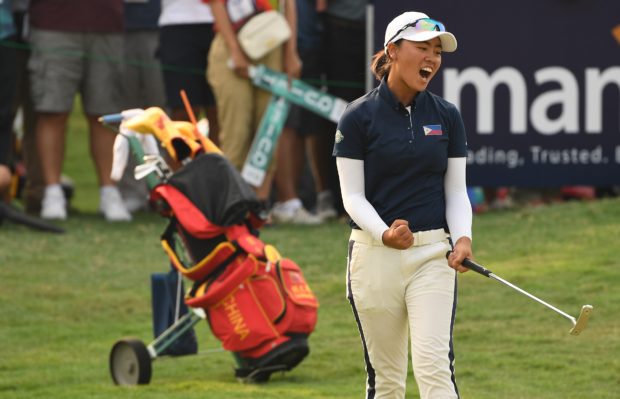
Yuka Saso of the Philippines celebrates winning the gold medal on her last putt during the final round of the women’s individual golf event at the 2018 Asian Games in Jakarta on August 26, 2018. / AFP PHOTO / PETER PARKS
There was a split-second moment of silence—less suspenseful and more expectant—among the country’s top golf officials when the question of Yuka Saso’s dual citizenship cropped up.
Saso, the country’s latest golf sensation, owns both Filipino and Japanese passports, and someone had remarked that the dual citizenship meant she was also eligible to represent Japan in the Tokyo Olympics in 2020.
After all, the way she fought from three shots down in the last hole to win the individual crown and anchored a Philippines fight-back from nine strokes down in the final round to win the team crown in the recent Asian Games would make her a tantalizing prospect for any country—especially one she actually has roots in.
Masakazu Saso, Yuka’s father, broke the silence.
“If Yuka plays in Olympics,” he said in broken, heavily-accented Filipino while tracing a flag-shaped figure in the air with his fingers, “Philippine flag.”
“I grew up here and [trained] here so if I play in the Olympics, [it will be for the] Philippines,” Saso told the Inquirer.
It was a reply everybody expected. But there was still a sense of relief among golf officials present over the declaration. But it is also the easiest claim to make, especially since no one really signs a document signifying an unbreakable pact to play for the country.
Recently, however, Saso and her fellow golf heroines didn’t just profess a love for country. They put their money where their mouths are and donated close to P17 million in incentives, a bounty they earned when they brought home two golds and one bronze from the Indonesia Asiad, to the country’s grassroots golfing program.
It was a whopping amount to surrender for the chance to retain their amateur status and be able to represent the country in international competitions. Especially for Saso, who owns a bulk of that prize. She earned close P8 million for her individual gold medal and an additional P2.7 million as her share from the team gold pot.
But for Saso, who once contemplated on turning pro immediately after finishing her high school studies in Japan, the many options now available for her made the decision easy.
“I know it will benefit me to play in college and if it were up to my father, I would play in college first before turning pro,” Saso said. If the golfers took the money, they would be ineligible for the US NCAA and, worse, would no longer be allowed to play for the country in a lot of major international tournaments.
Both Pagdanganan and Go see action in the US NCAA and Saso hopes to join them in the varsity circuit after high school. Masakazu chimed in, saying college would prepare his daughter physically for the rigors of the professional tour.
And Saso’s dad carries some weight on the young golf ace’s plans with her career.
“He’s been with me on the course since I was a kid,” Saso said. “Everything he tells me helps me because he knows me well.”
Currently, Saso is setting her sights on representing the country in golf’s biggest stage. And the NGAP is riding a different high after the Asian Games.
“We now have heroes on pedestals who can now helps us develop golf,” said Martin Lorenzo, the NGAP president.
But momentum won’t be enough to carry the golf heroines to the Olympics. And once any of them gets there, the competition will be a whole lot tougher.
“They need to go through several qualifying events,” said NGAP secretary-general Bones Floro. “And in the Olympics, remember that the pros can play.”
But at least, the NGAP has a place to start. There are three young golfers eager to give their best to wear the national colors. “Just representing the Philippines is a source of pride,” Saso said. And they just proved they would give up anything to be able to compete for the flag.
Even P17 million.